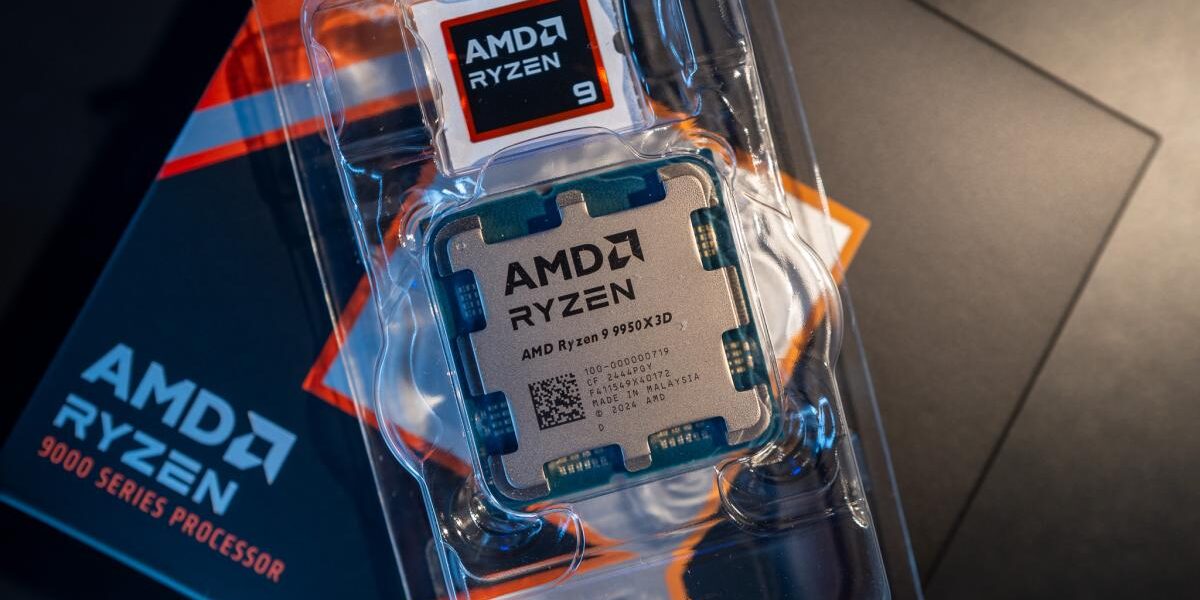AMD Ryzen 9 9950X3D review: The best all-around processor you can buy today
Note: This review was first published on 11 March 2025.

After launching the very gaming-oriented and 3D V-cache equipped Ryzen 7 9800X3D processor, we knew it was just a matter of time before AMD launches an X3D-version of their flagships Ryzen 9 9950X and 9900X processors – the Ryzen 9 9900X3D and Ryzen 9 9950X3D. just like they have done with the previous generation Ryzen 7000 Series.
In our review of the Ryzen 7 9800X3D, we proclaimed it the best gaming processor of this generation and for its value it still is. But its 8-core count meant that it could never outperform the Ryzen 9950X at content creation and even some productivity workloads, which comes with double the core count at 16. Conversely, the Ryzen 9 9950X’s only weakness is with gaming; it could not even keep up with the older Ryzen 9 7950X3D. This highlights the impressive technology of AMD’s 3D V-Cache.
But what is 3D V-Cache?
To put it very simply, 3D V-Cache is an AMD technology that enables it to vertically stack cache onto a CPU. This allows AMD to increase the processor’s memory, without having to increase the size of the die or shrink its logic circuits and thus allowing it to triple the L3 cache of its processors. This has the benefit of improving the CPU’s performance despite retaining the same architecture, and number of cores and threads.
But why is L3 cache so important? Well, more L3 cache allows the processor to stream and store more instructions, decreasing the number of times it needs to pull instructions from RAM. Naturally, this doesn’t provide a performance benefit in all situations. However, in scenarios where the CPU is handling multiple instructions, such as gaming, an additional L3 cache should provide a big uplift.
The first processor to be given 3D V-Cache treatment is the Ryzen 7 5800X3D (read our review) that was launched back in 2022, and AMD has continuously finetuned the technology over the next two generations of Ryzen processors – leading up to the Ryzen 7 9800X3D, Ryzen 9 9900X3D and 9950X3D. We don’t have the 9900X3D this time, but AMD did send the new flagship 9950X3D for us to test.

Both the Ryzen 9 9900X3D and 9950X3D processors come with some architectural changes that further optimise performance. Like the Ryzen 7 9800X3D, one significant adjustment is the reorientation of the second-generation 3D V-Cache die, now placed at the bottom of the chip instead of on top of the compute die. This change allows the chips to run cooler, thereby offering the potential for better clock speeds and greater efficiency. The CPU cores still receive some heat from the cache chip, but this setup improves thermal efficiency and allows for overclocking too.
Like the 9950X, the Ryzen 9 9950X3D has two CCDs with eight CPU cores each, but only one CCD has the 3D V-Cache chip. This tight packaging is essential as it reduces latency and helps to support faster operations and more bandwidth, and also allows the second CCD to run at higher clock speeds without extra heat. This additional cache boosts performance in bandwidth-intensive tasks, benefiting games at 1080p with high frame rates and heavy archive work.
| Ryzen 9 7950X3D |
Ryzen 7 9800X3D
|
Ryzen 9 9900X
|
Ryzen 9 9900X3D (New) |
Ryzen 9 9950X
|
Ryzen 9 9950X3D (New) | |
|---|---|---|---|---|---|---|
| Architecture | Zen 4 X3D | Zen 5 | Zen 5 | Zen 5 X3D | Zen 5 | Zen 5 X3D |
| Cores | 16 | 8 | 12 | 12 | 16 | 16 |
| Threads | 32 | 16 | 24 | 24 | 32 | 32 |
| Base clock speed | 4.2GHz | 4.7GHz | 4.4GHz | 4.4GHz | 4.3GHz | 4.3GHz |
| Boost clock speed | 5.7GHz | 5.2GHz | 5.6GHz | 5.5GHz | 5.7GHz | 5.7GHz |
| L3 cache | 128MB | 96MB | 64MB | 128MB | 64MB | 128MB |
| TDP | 120W | 120W | 120W | 120W | 170W | 170W |
| PPT | 162W | 162W | 162W | 230W | 230W | 230W |
| Launch Price (USD) | $699 | $479 | $499 | $599 | $649 | $699 |
But it’s not just the hardware that AMD has improved, because Team Red has also made significant updates to its chipset drivers.
You see, AMD’s approach to its dual-chiplet X3D processors has always revolved around making sure game workloads are directed to the right place – namely, the chiplet with the stacked 3D V-Cache. With the Ryzen 9 7950X3D, this was achieved by employing a thread targeting that works in tandem with putting unused cores to sleep, and forcing the game to run on the single chiplet that houses the power-boosted L3 cache. The downside? If you later swapped out the processor for a single-CCD variant, you could end up with lingering settings that refused to play nice, requiring nothing less than a full Windows reinstall to fix the issue. It wasn’t exactly an elegant solution – especially for DIY enthusiasts.


AMD has since fine-tuned its approach with an updated Provisioning Packages Service, which is responsible for managing core parking and thread scheduling. Now, after around 15 minutes of idle time, the system automatically recognises when a different processor has been installed and reconfigures itself accordingly. This means you can swap between X3D and non-X3D chips without worrying about OS-level conflicts, making the experience as seamless as it should have been from the start. On top of that, AMD has also improved compatibility with its 3D V-Cache Performance Optimizer, so users with Virtualization-Based Security (VBS) enabled in Windows 10 won’t run into unnecessary headaches.
While these refinements ensure better overall performance management, they don’t solve every issue. Some game titles still struggle with the dual-CCD design, leading AMD to bring back an old trick from its Threadripper days: the Application Compatibility Database (ACD). This is essentially a curated list of games that have trouble adapting to the dual-chiplet architecture. When one of these titles is launched, the system steps in and reduces the number of active threads, making them invisible to the OS and forcing the game to run on the optimised cores. Internally, AMD refers to this as ‘Core Lie’ – a mechanism that tricks the OS into seeing a different core count than what’s physically present. It’s a necessary workaround for stubborn titles that don’t play well with a dual-CCD setup, ensuring performance remains consistent across the board. The list of games isn’t exhaustive at the moment, but AMD says it will add more over time.
Ready to see how the Ryzen 9 9950X3D fare? Read on.

My AM5-based test platform for the Ryzen 9 9950X3D remains the same as the one used to review the recent NVIDIA and AMD graphics cards.
- ROG Crosshair X870E Hero
- Samsung 990 Pro 1TB SSD
- Kingston Fury 32GB DDR5 memory
- NVIDIA GeForce RTX 5080 Founders Edition
- Windows 11 OS
Gaming performance
My game list includes a mixture of old and recent games to test these processors’ performance, and while the list isn’t exhaustive by any measure there are enough different game engines and APIs variety to give us an idea of broader performance trends.
1080p benchmarking is a great measure of a CPU’s prowess because at lower resolutions, the GPU can process and transfer data much quicker than at higher resolutions. A CPU bottleneck happens here because the processor cannot keep up with the processing speed of the graphics card. The CPU, after all, is responsible for processing real-time game actions, physics, UI, audio and other complex CPU-bound processes.
While it’s unlikely a Ryzen 9 9950X3D will be used for playing games at 1080p, the results at this resolution can clue us in the chip’s the raw power when it comes to gaming.

Like the X3D-based processors before it, the Ryzen 9 9950X3D crushed Shadow of the Tomb Raider. The game makes full use of the X3D processors’ higher L3 cache, and the difference in framerates between it and the 9950X is quite stark. But as we can see at higher resolutions that advantage tapers until it level out at 4K, where the GPU becomes the bottleneck.

Unlike Shadow of the Tomb Raider, Total War: Warhammer III is a good example of how games that don’t take advantage of the X3D’s higher L3 cache will not see any performance benefits between the X3D and non-X3D versions of the same processor.

Marvel’s Guardians of the Galaxy is another great example of a title that takes advantage of 3D V-Cache to boost the game’s performance. Here, we see the 9950X is not even a match to a last-generation 7950X3D processor nor the more ‘budget-friendly’ 9800X3D.

Returnal, along with Total War: Warhammer III, is one of the rare game where all the Ryzens performs pretty neck-to-neck.

Playing Cyberpunk 2077? Your game will see a performance boost with any of the X3D-based processors from the 7000 and the current 9000 Series. It might be very fine marginal gains against the Ryzen 7 9800X3D, but the Ryzen 9 9950X3D is easily the best processor for gaming.
Productivity and Content Creation

In Procyon’s Office productivity test, the 9950X3D may not offer much in the way of improvements over the 9950X. It follows a similar pattern that we have seen before, where X3D processors do not gain noticeable uplifts in productivity and content creation workloads compared to their non-X3D equivalent (e.g., the 7950X versus the 7950X3D). But it’s worth pointing out that there’s a substantial generational leap over its direct predecessor, the 7950X3D.

In content creation tasks like video encoding with Handbrake, you can’t go wrong with both the X3D and non-X3D variants of the 9950X. But once again, the 9950X3D has shown some pretty impressive generational improvements over the 7950X3D.

The Procyon AI Computer Vision is an interesting benchmark because it measures the AI Inference performance with integer and float models using a CPU or GPU. While it’s more efficient to leave AI-related workloads to a discrete (and more efficient) GPU, this benchmark helps to reveal the raw power of a CPU.
Power and thermal efficiency

With more cores (than the 9800X3D) and a higher PPT (than the 7950X3D), it’s no surprise that the Ryzen 9 9950X3D runs the hottest compared to the rest of the X3D processors. But compared to the 9950X, it’s worth highlighting that the 9950X3D actually runs cooler while performing most tasks a whisker better. It also should be mentioned that with a maximum package power tracking (PPT) of 230W, the new pair of 9900X3D and 9950X3D have pretty good overclocking headroom too.
Final thoughts

The AMD Ryzen 9 9950X3D easily earns its position as the top gaming processor in AMD’s X3D lineup, standing shoulder to shoulder with the Ryzen 7 9800X3D as one of the best gaming CPUs available today. AMD’s refinements to its 3D V-Cache technology have largely addressed the trade-offs that once hindered productivity performance, making this processor an undeniably strong option for those who are looking for both top-notch gaming performances and serious multi-threaded muscle for work. Meanwhile, Intel’s Core Ultra 9 285K (read review here), despite the multiple chipset driver and Windows updates, still fell short in both gaming and productivity when compared to the non-X3D Ryzen 9 9950X – much less against AMD’s latest X3D flagship.
The 9950X3D also impresses in creative workloads, keeping pace with the standard Ryzen 9 9950X and the increased power draw – something that is usually a point of concern – has actually worked in AMD’s favour this time. Unlike its 7950X3D predecessor, which was constrained by thermal limitations due to its 3D V-Cache placement, the 9950X3D benefits from AMD’s revised chiplet arrangement, allowing for significantly better heat dissipation. The result is a CPU that can make full use of its higher PPT, boosting both gaming and productivity performance without the same thermal bottlenecks as before.

AMD is also launching the 9900X3D at the same time as the 9950X3D, but I thought the marginal price difference between the two processors makes the former’s value less attractive. I’ve not tested the 9900X3D, but the safer bet is on the 9950X3D. That said, availability could come into play in your decision between either X3D processors (still, do check out reviews of the 9900X3D first). Given how quickly the 9800X3D flew off shelves, early demand for the 9950X3D and 9900X3D is likely to be just as strong, and supply constraints could make it difficult to purchase one at its launch SRP. But for those willing to hunt one down, or wait for one, the Ryzen 9 9950X3D is definitively, without a doubt, the best all-around processor you can buy today.
The Ryzen 9 9950X3D (US$699) and Ryzen 9 9900X3D (US$599) will be available for sale starting from 12 March, 2025.




